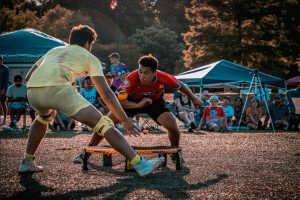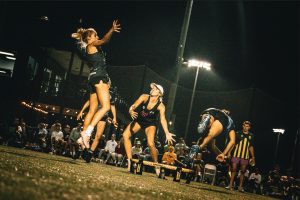Sports & Fitness
126 The History of Roundnet
Kade Janikula
Introduction
Roundnet, a dynamic and exhilarating sport, has surged in popularity worldwide, captivating players and spectators alike. At its core, roundnet involves teams of two competing to bounce a ball off a small circular net, showcasing agility, teamwork, and strategy. Their goal is to be the last team to hit the ball onto the net before the ball contacts the ground. Each team has three alternating hits to return the ball to the net. Originating as a backyard pastime, roundnet has undergone a remarkable transformation, evolving into a highly competitive sport with a dedicated following around the globe. This chapter explores the rich history and evolution of roundnet, tracing its humble beginnings to its current status as a global, growing phenomenon.
Origins of Roundnet
In the late 1980s, roundnet, initially known as “Spikeball,” was invented by Jeff Knurek and found by Chris Ruder in the United States. Chris Ruder was introduced to the game as a kid in the late 1980s, when his neighbors found it in a toy store. He and his brothers would play with their neighbors constantly growing up, and the seed was planted then. Chris went another 20 years before reaching out to family and friends, seeing if they had any interest in bringing the game back to life, and he found some positive responses from those he reached out to. with support from his friends and family, Ruder started the company “Spikeball”. Initially conceived as a casual beach game, it quickly gained traction among friends and family. The game’s simple yet addictive nature sparked interest beyond leisurely gatherings, prompting Spikeball and other sport leaders to refine its rules and equipment. Over time, roundnet evolved from a recreational activity to a competitive sport, driven by the enthusiasm of its early adopters.
Spread and Evolution
With the advent of the internet and social media, roundnet experienced a surge in popularity, spreading rapidly across the globe. Schools, parks, and communities embraced the sport, organizing informal matches and tournaments. As interest grew, dedicated leagues and organizations emerged, providing structured platforms for players to compete and hone their skills. Colleges, youth groups and beaches were common epicenters of popularity. Concurrently, the rules and gameplay of roundnet underwent iterative changes, with players experimenting with new strategies and techniques. This evolution culminated in the standardization of equipment and court specifications, establishing a uniform playing field for competitors worldwide.
Rise to Prominence
The ascent of roundnet to mainstream recognition was propelled by increased media coverage, which showcased the sport’s fast-paced action and competitive spirit. Key events and standout players garnered attention, captivating audiences and fueling interest in the sport. Roundnet’s popularity transcended borders, influencing communities globally and inspiring a new generation of athletes. Recognizing its growing significance, sports organizations began integrating roundnet into official competitions and events, solidifying its status as a legitimate sport.
Challenges and Controversies
Despite its rapid growth, roundnet encountered challenges along the way. Initially met with skepticism and resistance from traditionalists, the sport faced scrutiny over its legitimacy and rules. Controversies and rule disputes occasionally marred tournaments, prompting stakeholders to address concerns and refine regulations to ensure fair play and sportsmanship. Unification was helped by the inception of governing bodies, such as the USAR (United States Association of Roundnet) and the IRF (International Roundnet Federation). These organizations allowed for disputes to be easily handled, and universal rules to be put into place. It also allowed for rules and common practices to be made standard at the local, regional and national level.
Connection to STS
Roundnet is a growing sport, with a lot of hurdles to face, and a lot of success so far. This sport is a product of the society it resides in and looks different for different people. From the Philippines to Canada, people everywhere are discovering the sport of roundnet, and the sport is benefitting from it. Rules are being refined, equipment is being produced, and the competition is only getting more intense. Social media has played a massive role in the growth of the sport, from online coaching to film review, pickup groups to city leagues, the impact social media has had on this sport is unlike any others. Platforms like Discord and Facebook have been trampolines for lovers of the sport to bounce off of into their own regional communities.
Future Prospects
Looking ahead, the future of roundnet brims with promise and potential. Continued growth and expansion are anticipated, with aspirations for Olympic inclusion on the horizon. Innovations in technology and equipment are expected to enhance the sport’s accessibility and competitiveness. However, challenges such as maintaining integrity and fostering inclusivity remain paramount. Strategies to promote diversity and equitable participation will be pivotal in shaping the sport’s trajectory and ensuring its enduring appeal.
Conclusion
In conclusion, the evolution of roundnet from its humble beginnings to its current global prominence is a testament to the passion and dedication of its community. As the sport continues to evolve and thrive, its impact on sports culture and society at large is undeniable, underscoring its enduring legacy in the realm of competitive athletics.
Image References
Jacob Narayan, P.(2023). Rogue29[Photograph]. Googe Drive. https://drive.google.com/drive/folders/1-DAR-zLn5Q4z6xUkhVk17AnlSo0puHoQ
Jacob Narayan, P.(2023). Twinz20[Photograph]. Googe Drive. https://drive.google.com/drive/folders/1-DAR-zLn5Q4z6xUkhVk17AnlSo0puHoQ
REFERENCES
19, M., & 2023. (2023, May 19). Spikeball is In. Come One, Come All. University Wire http://libproxy.clemson.edu/login?url=https://www.proquest.com/wire-feeds/spikeball-is-come-one-all/docview/2874171434/se-2
Hendershot, S. (2015). Meet the guy who made Spikeball a thing. Crain’s Chicago Business, 38(25), 0004.
About Us. USA Roundnet. (n.d.). https://www.usaroundnet.org/about-us
C.Ruder, personal communication, April 15, 2024
B.Dantowitz, personal communication, April 8, 2024
Scotti, J. (2021, February 6). Pathway to the Olympics. International Roundnet Federation. https://roundnet.squarespace.com/initiatives/pathway-to-olympics
AI Acknowledgment
I acknowledge the use of ChatGPT https://chat.openai.com/ to format an outline and write my textbook chapter. The prompts used were “Design an outline for a 6 paragraph textbook chapter about the history of roundnet” and “Use the outline to write a 6 paragraph textbook chapter”. The outputs from the prompts were then edited and utilized in this chapter.



